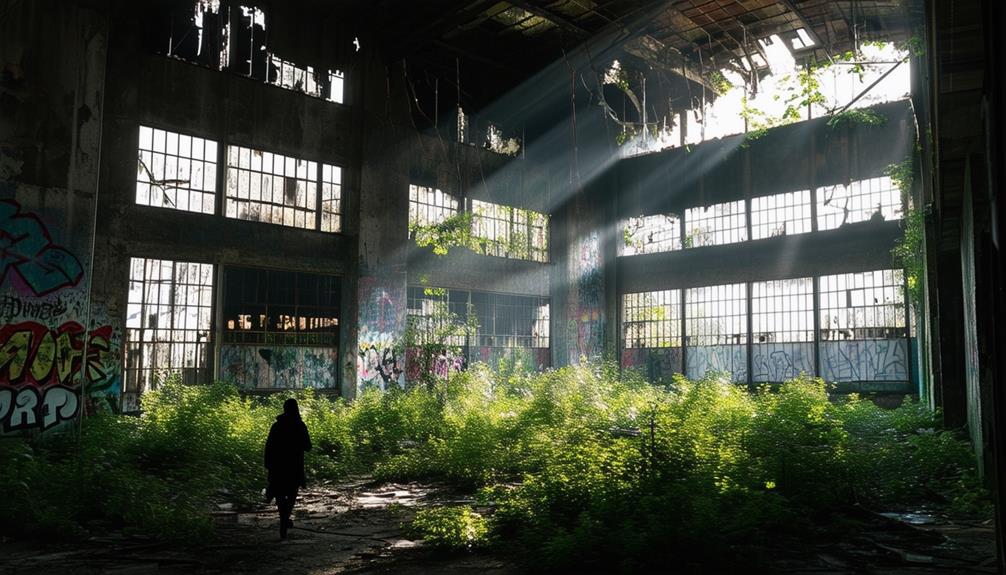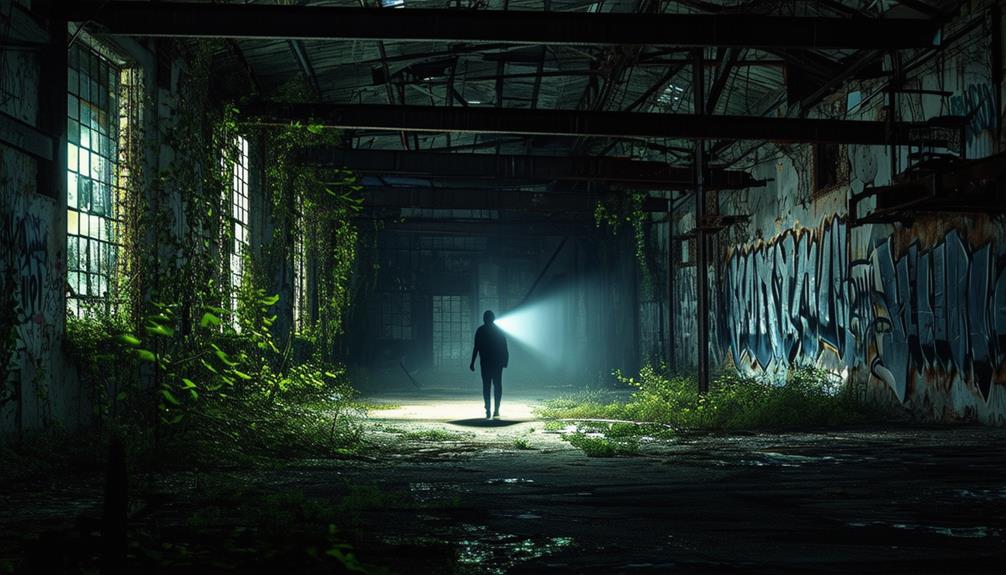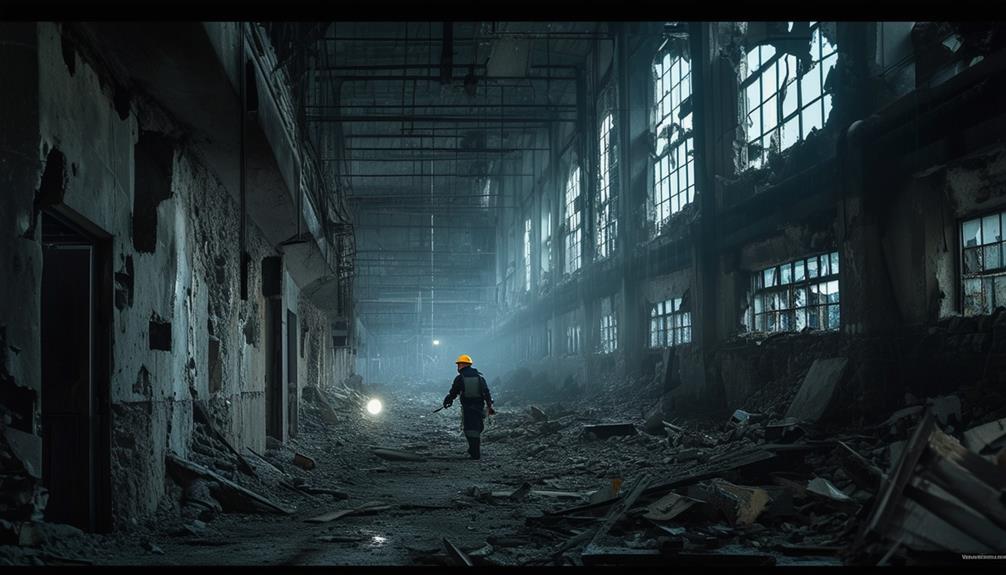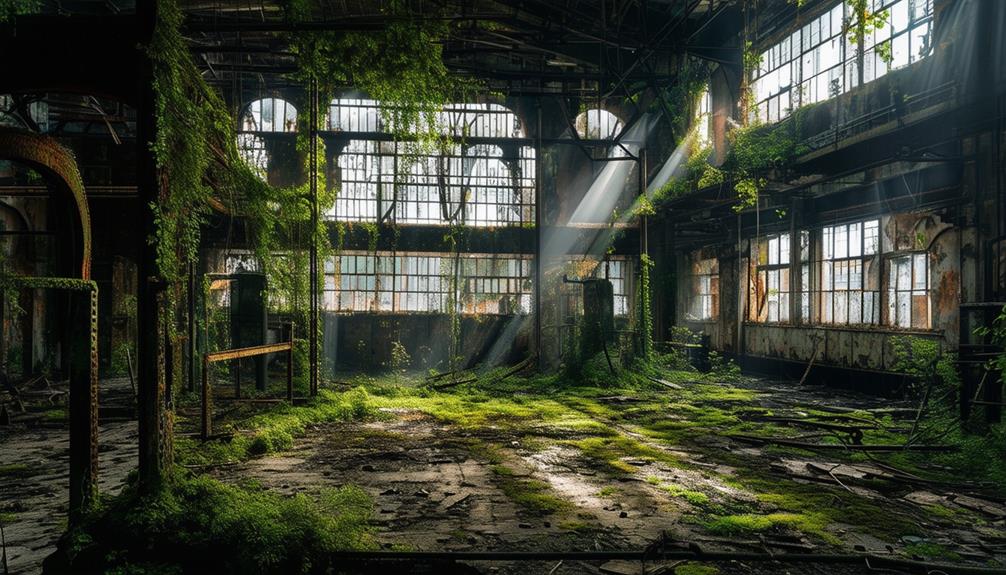Urban Exploration (Urbex): Exploring Abandoned Buildings

Urban exploration, or urbex, combines history and adventure as you navigate abandoned buildings. This activity is not merely about trespassing; it's about uncovering the long-lost stories embedded within these forgotten spaces.
Imagine the excitement of entering an abandoned factory, where each creak of the floorboards hints at its storied past. However, before embarking on such explorations, it is crucial to consider the necessary gear and safety measures. Urbex involves more than meets the eye, with each location offering its own unique narrative waiting to be discovered.
Key Takeaways
- Urban exploration (Urbex) provides the excitement of discovering and documenting forgotten places, revealing their unique stories through remnants.
- Essential gear includes sturdy footwear, reliable light sources, protective clothing, and spare batteries.
- Networking with fellow urbex enthusiasts and consulting historical records can enhance exploration experiences.
- Understanding trespassing laws and obtaining necessary permissions are crucial for legal and stress-free exploration.
- Photography and preservation efforts underscore the historical significance of abandoned buildings and advocate for their protection.
The Appeal of Urbex

The allure of urban exploration (urbex) lies in the thrill of discovering forgotten places and capturing their haunting beauty. When you delve into abandoned buildings, you're not just entering vacant spaces; you're embarking on a journey through time. Each creaky floorboard and shattered window tells a story, inviting you to piece together the past. The adrenaline rush when you initially enter an abandoned site is unparalleled. You never know what you might find—hidden rooms, decaying art, or remnants of lives once lived.
Exploring these forsaken structures offers a rare glimpse into history's forgotten corners. The decayed architecture and urban neglect provide a unique aesthetic that's both eerie and captivating. You're drawn to the peeling paint, the overgrown vines reclaiming their space, and the silent halls echoing with memories. Each photograph you take captures the essence of decay and the passage of time, creating a visual narrative that's as compelling as it's haunting.
In urbex, the thrill isn't just about the unknown; it's about connecting with the past and documenting a world that's slowly disappearing. It's an adventure, an exploration, and a tribute to forgotten beauty.
Essential Gear
When preparing for urban exploration, ensure you have:
- Sturdy footwear
- Reliable light sources
- Protective clothing
These essential items will help you navigate safely through dark and potentially hazardous environments.
Sturdy Footwear Necessities
Exploring abandoned buildings necessitates sturdy footwear to shield you from debris, broken glass, and unstable surfaces. The deteriorating floors and staircases typical of such environments make proper footwear essential. Quality boots or shoes provide the necessary traction and ankle support to navigate these risky conditions safely.
In these settings, you'll encounter sharp objects, rusty nails, and other potential hazards. Durable footwear serves as a protective barrier, preventing injuries that could otherwise abruptly end your adventure. Lightweight yet robust boots are ideal for the extended walking and climbing common in urban exploration, offering essential protection without adding undue weight.
Choosing the right footwear not only prevents injuries but also enhances overall comfort. Good grip and cushioning minimize slips and discomfort. Investing in high-quality footwear means fewer concerns about your feet, allowing you to focus on the thrill of urban exploration. The right gear is crucial for ensuring both safety and enjoyment in these fascinating, forgotten spaces.
Reliable Light Sources
Navigating through the pitch-dark hallways of an abandoned building requires reliable light sources to ensure your safety and visibility. Urban exploration demands tools that provide powerful and dependable illumination, so consider the following light sources:
LED Flashlights: These are essential for general exploration. They offer powerful, compact, and durable illumination, making them perfect for spotting potential hazards.
Headlamps: Ideal for climbing stairs or crawling through narrow spaces, headlamps provide hands-free, directional lighting. This allows you to keep your hands free for maintaining balance or holding onto railings.
Portable Lanterns: With adjustable brightness levels, portable lanterns are excellent for lighting up larger rooms or open areas. They provide a broad spread of light, making it easier to see the entire space at a glance.
Glow Sticks: Lightweight and easy to store, glow sticks are a great backup if your primary light source fails. They can be conveniently kept in your backpack as an emergency option.
Spare Batteries or Power Banks: To ensure uninterrupted illumination, always carry spare batteries or power banks. This preparation guarantees you won't be left in the dark during extended exploration trips.
| Light Source | Advantages | Best Use |
|---|---|---|
| LED Flashlights | Compact, powerful, durable | General exploration |
| Headlamps | Hands-free, directional light | Climbing, navigating |
| Portable Lanterns | Adjustable brightness, wide coverage | Illuminating large areas |
| Glow Sticks | Lightweight, emergency backup | Backup lighting |
Reliable light sources are non-negotiable for safe urban exploration. Always be prepared with these essential tools before venturing into the unknown!
Protective Clothing Essentials
Ensuring your safety during urban exploration requires not only reliable light sources but also appropriate protective clothing to guard against various hazards. Start with sturdy boots. These protect your feet from sharp objects and debris commonly found in abandoned buildings.
A respirator or mask is also critical, as it filters out dust, mold, and other harmful particles prevalent in these neglected structures. Thick gloves are essential to shield your hands from cuts, injuries, and exposure to hazardous materials.
Long-sleeved shirts and pants provide a necessary barrier against scratches, insects, and potential contaminants you might encounter. Additionally, a headlamp or flashlight is indispensable for navigating dark areas and preventing trips and falls in poorly lit spaces.
Finding Locations

To find the best urban exploration spots, begin with thorough online research to gather comprehensive information. Networking with fellow explorers can offer valuable insights and tips. Additionally, consulting historical records can reveal hidden gems that aren't widely known.
Online Research Techniques
When searching for abandoned buildings to investigate, start by exploring online forums and social media groups dedicated to urban exploration. These platforms are rich sources of information where enthusiasts share details about abandoned locations, including how to access them and what to expect. Online research is essential for finding these hidden gems.
Google Maps and its satellite imagery are also effective tools. By examining these maps, you can identify potential abandoned sites by looking for signs like overgrown vegetation, broken roofs, and lack of cars. Urban exploration websites and databases often list abandoned sites with detailed information on access and safety, making them invaluable resources.
Blogs, articles, and documentaries provide insights into the history and current status of potential investigation sites. This background knowledge not only enriches your experience but also helps you prepare for what you might encounter.
Quick Overview of Online Resources:
| Resource Type | Description | Example Sites |
|---|---|---|
| Online Forums | Community-driven discussion boards | Reddit, UER.ca |
| Social Media Groups | Groups on platforms like Facebook and Instagram | Facebook Urbex Groups, Instagram #UrbanExploration |
| Urban Exploration Websites | Databases listing abandoned locations and details | Atlas Obscura, Abandoned America |
Utilize these online research techniques to uncover the most fascinating abandoned buildings waiting to be investigated.
Networking With Explorers
Enhancing your urban exploration through networking can significantly expand your horizons and improve your investigations. Social media platforms like Instagram, Twitter, and Facebook are invaluable for connecting with fellow enthusiasts. By following hashtags related to urbex, you can discover stunning photos and gain insights into previously unknown locations. Engaging with these posts by commenting and messaging their creators can open doors to valuable connections and information.
Participating in urbex forums and threads is another effective way to broaden your network. Websites dedicated to urban exploration often have active communities where members share locations, tips, and experiences. Contributing to these discussions not only helps you learn about new sites but also builds relationships with experienced explorers who can offer practical advice.
Collaborating with fellow urbex enthusiasts can lead to more thrilling adventures and shared discoveries. Teaming up with others enhances safety measures and brings different perspectives to your explorations. Networking fosters a sense of camaraderie within the urbex community, making your adventures more rewarding and enjoyable. Sharing your own experiences and location information helps create a supportive network. This exchange enhances safety, provides fresh insights, and enriches the entire urbex experience.
Utilizing Historical Records
Exploring historical records can uncover hidden gems of abandoned buildings ideal for urban investigation. By examining old maps, newspapers, and city archives, you can find clues about forgotten locations. Property records and building permits often contain valuable information about the history and status of various structures. Historical photos can also provide visual references to aid your search.
Online databases and urban exploration forums are rich sources of information. Many urban explorers share their findings, offering leads on potential sites. Local history books can provide deeper insights into the backgrounds of these abandoned buildings. Census data and land surveys can further refine your search, helping to identify buildings that have been vacant for years.
Engaging with historians, preservationists, and local residents can yield firsthand accounts and stories about lesser-known abandoned buildings. These conversations can lead to discoveries not documented in traditional records. Architectural blueprints can offer detailed information about a building's layout, enhancing the safety and thoroughness of your investigation.
Legal Considerations
Navigating the legal landscape of urban exploration is crucial to avoid trespassing charges and ensure a safe experience. Law enforcement takes property rights seriously, so understanding the regulations before entering any abandoned building is essential. Trespassing laws can vary widely by location, so a bit of research can save you from hefty fines or even jail time.
Always seek permission from property owners. While it may seem inconvenient, obtaining explicit consent ensures you're not breaking the law and shows respect for the property and its owners. This respect is a core principle for many urban explorers and helps maintain a positive reputation for the urbex community.
Local ordinances regarding abandoned buildings can differ significantly. Some areas may have strict regulations, while others could be more lenient. Familiarizing yourself with these rules can help you avoid unexpected legal trouble.
Understanding the legal implications of urban exploration not only helps you enjoy the hobby responsibly but also demonstrates a commitment to preserving the integrity of the locations you visit. Prioritizing legal considerations ensures a stress-free and enjoyable urbex experience.
Safety Tips

When exploring abandoned buildings, always prioritize your safety by bringing essential gear like flashlights, masks, and gloves. A good flashlight is crucial for navigating dark environments and identifying potential hazards. Masks protect you from inhaling dust or toxic substances, while gloves shield your hands from sharp objects and rough surfaces.
Before you set out, inform someone of your location and your expected return time. Having a plan for emergencies is important, as urban exploration can be unpredictable. Knowing that someone is aware of your whereabouts adds an extra layer of security.
Be extremely cautious of the building's structural integrity. Abandoned structures often have unstable floors, weak ceilings, and other hazards that could lead to serious injuries. Always test surfaces before putting your full weight on them and avoid unnecessary risks.
Stay vigilant for security measures like motion detectors and guard dogs, which can pose physical risks and lead to legal issues. Always scout the area discreetly and plan your entry and exit points carefully.
Photography Techniques
Mastering urbex photography involves honing low-light techniques and using creative lighting to highlight the beauty of decay. Often, you'll be in dimly lit or completely dark environments. Use long exposure settings to capture the eerie charm of these locations, allowing more light to reveal hidden details in the shadows. Light painting with a flashlight or other light source can add dramatic effects to your shots.
Focus on textures and decay. Abandoned buildings offer a visual feast of peeling paint, rusted metal, and crumbling walls. Close-ups can emphasize these elements. Composition and framing are crucial—look for leading lines, symmetry, and interesting angles that tell the story of the space.
Post-processing is essential. Editing your photos can enhance details and atmosphere. Adjust contrast, brightness, and shadows to create a compelling narrative. Urbex photography combines technical skills and a creative eye to transform forgotten places into captivating works of art. So, grab your camera and start exploring!
Famous Urbex Sites

After perfecting your photography skills, it's time to explore some of the world's most renowned urban exploration (urbex) sites, each offering unique opportunities to capture the haunting beauty of decay.
Leading the list is the Chernobyl Exclusion Zone in Ukraine, with the abandoned city of Pripyat serving as a stark reminder of the 1986 nuclear disaster. Its deserted buildings and eerie remnants are a photographer's paradise.
In the United States, the City Methodist Church in Gary, Indiana, is a must-visit. This abandoned site is celebrated for its stunning decay and grand architecture, providing a unique backdrop for your shots.
For a surreal experience, visit the Six Flags New Orleans amusement park. Left in ruins after Hurricane Katrina, this site offers an eerie exploration experience with its decaying rides and overgrown pathways.
For a more forbidden adventure, North Brother Island in New York City, once a quarantine hospital, remains highly restricted. However, its rich history and decaying structures make it a coveted spot for urbex enthusiasts.
Lastly, don't miss the Eastern State Penitentiary in Philadelphia. Known for its imposing Gothic architecture and haunting atmosphere, this abandoned penitentiary is a must-see destination for any serious urban explorer.
Sharing Your Experience
Sharing your urban exploration experiences through captivating photography and storytelling can deeply engage and inspire your audience. When you capture the essence of modern ruins in places like New York, you're not just sharing images; you're telling a story that evokes curiosity and emotion. Use your photos to highlight the eerie beauty of abandoned buildings and the history they hold, and pair them with compelling narratives that transport your followers into the heart of your adventure.
Connect with like-minded urban exploration enthusiasts on social media platforms to exchange tips, locations, and experiences. Instagram, Facebook groups, and urbex forums are great places to start. Sharing your discoveries and learning from others can enhance your exploration skills and broaden your network.
Create a compelling narrative around each exploration. Describe the sights, sounds, and feelings you experienced to intrigue your audience and raise awareness about the significance of preserving these decaying sites. Discuss urbex ethics, safety measures, and the importance of location preservation in online forums and communities.
Collaborate with other explorers to create impactful projects. Joint ventures can amplify the message about urban decay and the need for preservation, making your urban exploration stories even more powerful.
Frequently Asked Questions
Is It Illegal to Explore Abandoned Buildings in the Us?
Exploring abandoned buildings in the US can be illegal if it involves trespassing on private property without permission. Penalties vary by state, so it is important to research local laws and obtain permission to avoid legal issues.
What Do You Call People Who Explore Abandoned Buildings?
You call them urban explorers or urbexers. They venture into abandoned buildings to document their history and beauty. These explorers typically adhere to a code of ethics, respecting the sites and ensuring they leave no trace behind.
What Is the Golden Rule of Urbex?
The golden rule of urban exploration is to leave nothing behind but footprints. This means refraining from stealing, vandalizing, or damaging anything. Respect the site's history and integrity to preserve it for future explorers.
How Do I Start Exploring Abandoned Buildings?
Begin by researching local abandoned buildings through urbex forums and social media. Equip yourself with essential gear such as flashlights, gloves, and sturdy footwear. Inform someone of your plans and location for safety. Adhere to ethical practices, including respecting property and not vandalizing. Start with less risky sites like abandoned houses or factories to gain experience.
Conclusion
You're now equipped to dive into urban exploration. Remember to pack essential gear, adhere to legal boundaries, and prioritize your safety. Each abandoned building holds a unique story, waiting for you to uncover and share it. Use your photography skills to capture these moments and connect with fellow urbex enthusiasts. By exploring these forgotten places, you're not just seeking adventure — you're preserving history, one photo at a time. Happy exploring!




